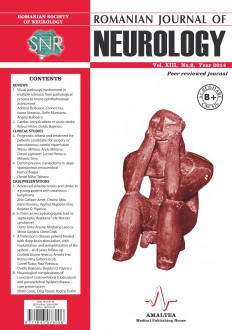SELECT ISSUE

Indexed

| |

|
|
|
| |
|
|
|

|
|
|
|
|
|
| |
|
|
HIGHLIGHTS
National Awards “Science and Research”
NEW! RJN has announced the annually National Award for "Science and Research" for the best scientific articles published throughout the year in the official journal.
Read the Recommendations for the Conduct, Reporting, Editing, and Publication of Scholarly work in Medical Journals.
The published medical research literature is a global public good. Medical journal editors have a social responsibility to promote global health by publishing, whenever possible, research that furthers health worldwide.
IS THERE AN ENCEPHALOGRAPHIC TRAIT TO SEPTO-OPTIC DYSPLASIA? (DE MORSIER SYNDROME)
Oana Tarta-Arsene, Madalina Leanca, Mona Gandea and Dana Craiu
ABSTRACT
Objectives. Septo-optic dysplasia (SOD), also known as de Morsier syndrome is a rare congenital syndrome involving variable midline brain structures, characterized by visual impairment, pituitary deficiencies and specific brain abnormalities (especially midbrain malformations). The clinical phenotype is highly variable, from mild to extremely severe. The purpose of this paper is to present the electroencephalographic abnormalities in two clinical cases and correlate with the ones that have been described in the literature in order to find a specific trait of this syndrome.
Methods and results. A 12-year-old girl was hospitalized in the pediatric neurology clinic for focal seizures, developmental delay and cerebral palsy. Clinical examination showed visual disturbances (nystagmus and oculomotor nerve palsy), unilateral pyramidal syndrome – left hemiparesis. Electroencephalography (EEG) revealedbilateral photosensitive epileptic form discharges, but asymmetrical, right more than left, with abnormal, slower background. MRI showed optic nerve hypoplasia and hypoplasia of the corpus callosum. The second case was also a girl, a 7-year-old who had only 2 focal right motor seizures with secondary generalization and developmental delay. Clinical examination showed visual impairment and bilateral nystagmus. The standard EEG evaluation didn’t reveal any abnormalities, with normal background. Cerebral MRI showedmidline brain defects – agenesis of the septum pellucidum, agenesis of corpus callosum and optic nerve hypoplasia. Endocrine evaluation for pituitary function showed in the first case – increased thyroid-stimulating hormone and in the second case – decreased IGF1. Antiepileptic treatment was started in both cases, but seizures were refractory to treatment and persistent EEG abnormalities still present in the first case, with good evolution of epilepsy in the second case.
Conclusions. The epileptiform abnormalities associated to SOD are present only if there is an associated cortical malformation.
Keywords: electroencephalography, septo-optic dysplasia, optic nerve hypoplasia, hypopituitarism
Full text | PDF
